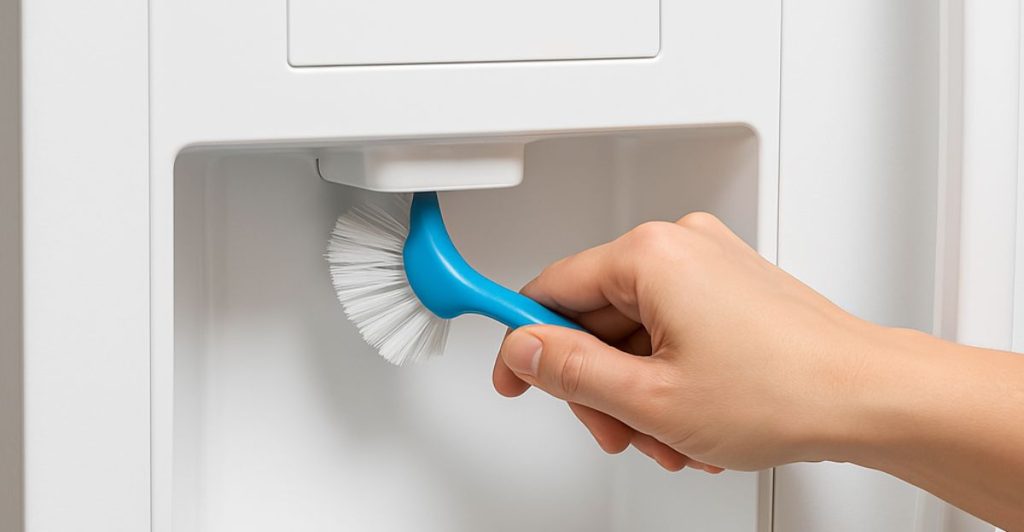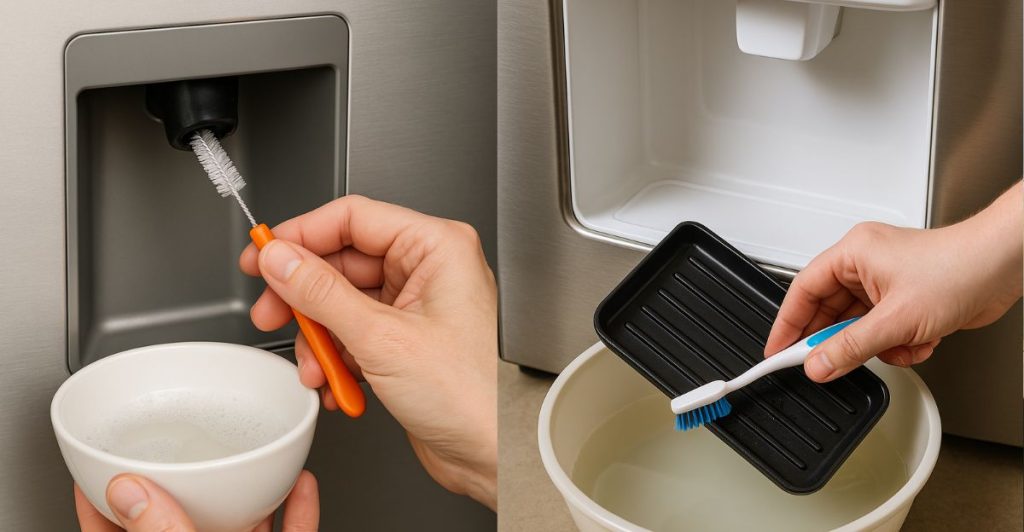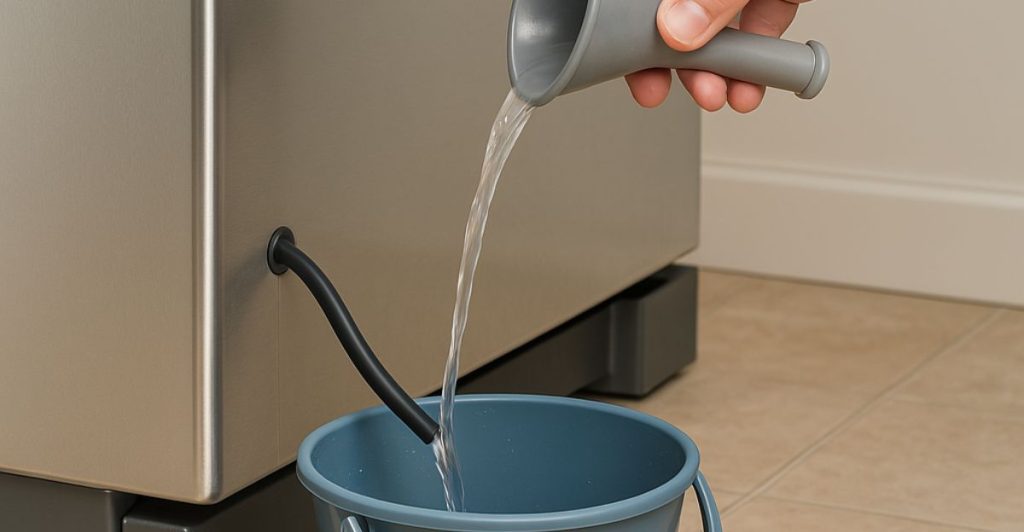Table of Contents
A refrigerator water dispenser provides a convenient way to enjoy fresh, chilled water without relying on bottled alternatives. However, many individuals may not be aware that these dispensers can become an unnoticed source of bacteria, mold, and slime over time.
Moisture and organic matter create a perfect place for harmful germs to grow. This can make the water unsafe to drink and cause health problems. Regular deep cleaning is important to keep the water fresh, safe, and clean.
This guide will take you through a step-by-step process to deep clean your fridge water dispenser using simple household ingredients. With the right approach, you can restore the dispenser to a hygienic state and maintain optimal water quality.
Signs Your Fridge Water Dispenser Needs Cleaning
Several signs indicate that your fridge water dispenser requires immediate cleaning.
- If your water has an off-putting taste or odor, this could be due to bacterial growth, mineral buildup, or a clogged water filter.
- A slow water flow often suggests that sediment or slime has accumulated within the dispenser or water lines, restricting the passage of water.
- Mold and slime may also be visible around the nozzle or in the drip tray, indicating significant contamination.
- Ice cubes with an unusual taste or odor could be another sign that the dispenser and connected components need to be cleaned.
Addressing these issues promptly will prevent further buildup and ensure that your water remains fresh and safe for consumption.

How to Deep Clean a Fridge Water Dispenser
Essential Supplies for Cleaning Your Fridge Water Dispenser
Gather the necessary supplies before starting the cleaning process.
Essential cleaning agents:
- Dish soap: Helps remove grease and grime.
- White vinegar: A natural disinfectant that kills bacteria and breaks down buildup.
- Baking soda: Effectively removes stains and neutralizes odors.
Cleaning tools:
- Bristled straw brush or pipe cleaner: Reaches inside the nozzle and tight spaces.
- Microfiber cloth or paper towels: Wipes down surfaces effectively.
- Toothbrush: Scrub stubborn residue and buildup.
- Lemon juice (optional): Adds a refreshing scent and enhances antibacterial properties.
These household items provide a thorough clean without the need for harsh chemicals.
Step-by-Step Guide For Deep Cleaning Your Fridge Water Dispenser
Here is the step-by-step guide for deep cleaning your fridge water dispenser.
Step 1: Cleaning the Nozzle
The dispenser nozzle is one of the most common areas where bacteria and mold accumulate. To clean it thoroughly, mix a solution of warm water and dish soap or equal parts vinegar and water.
Dip a straw brush or pipe cleaner into the solution and use it to scrub the inside of the nozzle. Pay special attention to any visible residue to ensure that all buildup is removed.
Once the nozzle has been scrubbed, rinse it with clean water until all soap or vinegar has been washed away. If the nozzle appears particularly dirty, soaking it in vinegar for ten minutes before scrubbing can help loosen stubborn grime.

How to Deep Clean a Fridge Water Dispenser
Step 2: Cleaning the Drip Tray
The drip tray beneath the dispenser collects excess water and can quickly become a breeding ground for bacteria and mold. Remove the tray and soak it in vinegar and water for at least fifteen minutes to clean it. This will help break down any mineral deposits and kill bacteria.
After soaking, use a toothbrush to scrub off any remaining stains or slime. Rinse the tray thoroughly with warm water and dry it before reinstalling it in the dispenser. Keeping the drip tray clean will prevent unpleasant odors and bacterial growth.
Step 3: Flushing the Water Line
The water line that supplies the dispenser can accumulate mineral deposits, bacteria, and mold over time. To clean it, first, turn off the water supply to the refrigerator and unplug the appliance. Locate the water line and disconnect it from the fridge, placing one end in a bucket to catch any excess liquid.
Using a funnel, pour white vinegar into the water line until it is fully saturated. If your fridge also has an ice maker, pour vinegar into the dispenser lines connected to the ice-making system. Let the vinegar sit for at least ten to twenty minutes to dissolve buildup and kill bacteria.
After allowing the vinegar to work, flush the water line with clean water until all traces of vinegar have been removed. Reconnect the water line to the fridge and restore the water supply. This step is crucial for eliminating bacteria and maintaining the purity of your drinking water.

How to Deep Clean a Fridge Water Dispenser
Additional Tips for Maintaining a Clean Fridge Water Dispenser
To keep your fridge water dispenser clean and free from contamination, it is recommended to clean it at least once a month. This regular maintenance will prevent bacteria and mold from accumulating and ensure that the water remains fresh.
Replacing the water filter every six months is another important step in maintaining water quality. Over time, filters become clogged with sediment and bacteria, reducing their effectiveness. A fresh filter will help ensure that contaminants are removed before the water reaches the dispenser.
To prevent hard water stains and mineral buildup, wipe the nozzle with vinegar weekly. This simple habit will keep the exterior of the dispenser looking clean and prevent residue from accumulating. Using lemon juice as a rinse can also leave the dispenser smelling fresh while naturally disinfecting the system.
Conclusion
Regular maintenance of your refrigerator water dispenser is essential for ensuring that your drinking water remains fresh, clean, and safe. By following a simple cleaning routine, you can prevent bacteria buildup, eliminate unpleasant odors, and extend the lifespan of your appliance.
Setting a monthly cleaning schedule will keep your dispenser in optimal condition while replacing the water filter every six months will maintain water purity. By incorporating these habits into your routine, you can enjoy clean, refreshing water every day.
FAQs
How do I remove hard water stains from the dispenser?
Hard water stains can be stubborn, but they can be effectively removed by soaking a paper towel in vinegar and wrapping it around the affected area. Allow it to sit for fifteen minutes before scrubbing it with a brush. This method helps dissolve mineral deposits and restore the dispenser’s appearance.
Why does my water still taste bad after cleaning?
If your water continues to have an unpleasant taste even after cleaning, the water filter likely needs to be replaced. Additionally, flushing the water lines with a mixture of filtered water and baking soda can help remove lingering odors and improve water quality.
Can I use bleach to clean my water dispenser?
Bleach is not recommended for cleaning a fridge water dispenser, as it can leave harmful chemical residues that may affect the taste of the water. Vinegar and baking soda are safer alternatives that effectively disinfect without introducing harsh chemicals.
